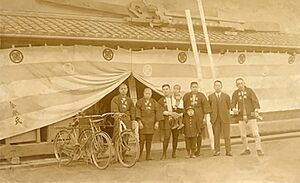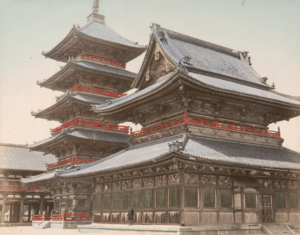Kongō Gumi facts for kids
 |
|
|
Romanized name
|
Kongō Gumi |
|---|---|
| Subsidiary (since 2006) | |
| Industry | Construction |
| Founded | 578 |
| Founder | Shigemitsu Kongō |
| Headquarters | , |
| Parent | Takamatsu Construction Group (2006–present) |
Kongō Gumi Co., Ltd. is a very old Japanese construction company. It started way back in 578 A.D., making it possibly the oldest company in the world! This company is famous for building, fixing, and restoring important Japanese buildings. They work on shrines, temples, castles, and other old cultural buildings. For a long time, Kongō Gumi focused on traditional building styles. But as new building methods like using concrete became popular, they faced more competition. In January 2006, Kongō Gumi became part of a larger company called the Takamatsu Construction Group.
Contents
A Long History of Building
Kongō Gumi was a family-owned business for over 1,400 years. Its main office was in Osaka, Japan. A special scroll from the 1600s shows how the company passed down through 40 generations.
The company continued through the founder's family members. Sometimes, if there were no sons, a son-in-law would join the family and take the Kongō name. This helped the company keep its name and traditions alive.
One big reason for the company's long life was its work on Buddhist temples. Millions of people in Japan follow Buddhism, so there was always a need for temple construction and repair. Over many centuries, Kongō Gumi helped build famous places, including the amazing Osaka Castle in the 1500s.
Kongō Gumi was also one of the first construction companies in Japan to use new materials. After the Meiji Restoration (a big change in Japan's history), they started using concrete along with wood to build temples. They also began using computer-aided design (CAD) to plan temple designs.
Changes and New Beginnings
The company faced tough times and had financial problems in the early 2000s. In January 2006, it was bought by the Takamatsu Construction Group. Before this, Kongō Gumi had about 100 employees. In 2005, it earned about 7.5 billion Japanese yen (around 70 million US dollars). It was still focused on building Buddhist temples.
The last president from the Kongō family was Masakazu Kongō. He was the 40th person from the family to lead the company. As of August 2025, Kongō Gumi is still working as a part of the Takamatsu Construction Group.
Important Dates in Kongō Gumi's History
- 578: Kongō Shikō started the company. He was one of three special carpenters called Miyadaiku. Prince Shōtoku invited them from Baekje (an ancient kingdom) to build Shitennō-ji temple.
- 593: Shitennō-ji temple was finished. The building methods used then are still part of Kongō Gumi's "assembly method" today.
- 1576: Shitennō-ji was burned down by Oda Nobunaga. Kongō Gumi helped build Osaka Castle around this time.
- 1614: Shitennō-ji burned down again during the Siege of Osaka. The temple has been rebuilt seven times because of wars and natural disasters. Each time, Kongō Gumi helped rebuild it.
- 1868: Shitennō-ji lost its special land and money. This meant Kongō Gumi could no longer get payments from the temple.
- 1903: Kongō Gumi built the Daimon Gate.
- 1934: The Shitennō-ji Gojū-no-tō (a five-story pagoda) fell down in a big typhoon. Yoshie Kongō, the first woman to lead the company, helped rebuild it.
- 1955: Kongō Gumi officially became a company.
- 2005: A new company, Shin-Kongo Construction, was created by Takamatsu Construction.
- 2006: Kongō Gumi transferred its business to Shin-Kongo Construction. Most of its employees moved to the new company. The old Kongō Gumi company changed its name to KJ Construction Co., Ltd. This meant the Kongō family no longer managed the company after over 1,400 years.
- July 2006: KJ Construction filed for bankruptcy because it didn't have enough money. It owed about 4 billion yen.
- July 2007: The company acquired all the shares of Nakamura Shaji, another construction company.
- May 2008: Kongō Construction Engineering was started. This new company specializes in building and fixing floats and portable shrines used in Japanese festivals. These include danjiri and mikoshi.
See also
- List of oldest companies



